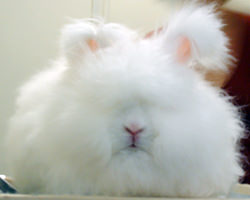

Angora rabbit breeds produce angora wool, which is used for creating fiber arts.
While many rabbit owners enjoy raising fancy rabbits for showing, many people have discovered the joy of raising rabbits for wool. And why not? You can enjoy the daily companionship of your rabbits while also reaping the benefits of their annual wool production—wool that is perfect for fiber-art enthusiasts.
Choosing Your Rabbit Breed
There are 47 rabbit breeds officially recognized by the American Rabbit Breeders’ Association, but only a few of these breeds exhibit angora wool, the type used for fiber arts. Angora rabbits produce super-soft wool that can be harvested again and again, year after year, just as is the case with the shearing of sheep.
The angora rabbit breeds include:
- English Angora:
An ancient rabbit breed that produces ample quantities of wool, the English Angora is one of the smaller angora rabbit breeds, weighing in at 5 to 7 pounds. The English Angora is noted for requiring extensive grooming. - French Angora:
Another ancient rabbit breed, the French Angora is known for producing wool that is a bit coarser than that of the English Angora. The French Angora does, however, require less grooming than the English Angora. The French Angora weighs in at 7½ to 10½ pounds. - Giant Angora:
You guessed it—the Giant Angora is the largest of all the angora rabbit breeds, weighing in at about 9½ pounds. The Giant Angora is only found in one color: ruby-eyed white. - Satin Angora:
Approximately the same size as a French Angora, the Satin Angora rabbit breed boasts a wool with a marvelous satin sheen. Satin Angoras produce less wool for harvesting.
Don’t overlook the Jersey Wooly, which is a dwarf rabbit breed with angora wool. It weighs in at less than 3½ pounds. Obviously, the wool production of a Jersey Wooly cannot possibly compete with that of the larger rabbit breeds, but the diminutive size of the Jersey Wooly makes it easy to care for. It also makes a nice “starter” rabbit breed for anyone wanting to get started with angora rabbits on a small scale.
Caring for Angora Rabbits
The basics of care are essentially the same for the angora rabbit breeds as they are for any other rabbit breed with the addition of the following:
- Regular Grooming
If you’re serious about raising angora rabbits, then you must be prepared for the grooming commitment. The long, flowing wool of angora rabbits needs regular (even daily) attention in order to keep it in prime condition. This rigorous grooming commitment is not something you encounter with the short-coated rabbit breeds, such as the Mini Rex or Dutch. - Dietary Needs
The basic parameters for feeding rabbits apply to angoras as well, but it’s important to provide ample quantities of hay for your angora rabbits. The fiber in the hay helps to keep their digestive systems in good working order and can help to prevent wool block (an internal blockage of hair). Many angora breeders recommend papaya tablets as an additional way to reduce the chances of wool block.
Wool You Join the Fun?
Generally speaking, you can harvest your angora wool by shearing each rabbit or plucking the fur by hand three or four times per year. (One exception, Giant Angoras typically need to be sheared rather than plucked). Wool harvesting does not hurt or harm the rabbits in any way. In fact, it’s essential for keeping their coats in prime condition. A good rule of thumb is to figure that the average rabbit will produce 8 to 32 ounces of wool per year (except for the Jersey Wooly, of course).
Angora wool is excellent for spinning and weaving, and you might not produce more than you will want to utilize yourself. However, if you do find yourself with abundant quantities of surplus wool you should have no trouble marketing it to eager fiber-art enthusiasts.
About the Author: Samantha Johnson is the author of The Field Guide to Rabbits (Voyageur Press, 2008) and How to Raise Rabbits (Voyageur Press, 2009). She has been a rabbit enthusiast for nearly 20 years.




